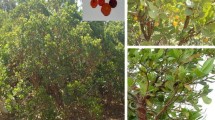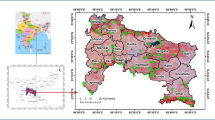Abstract
We conducted a study throughout Socotra Island (Yemen) to investigate the distribution, population structure and regeneration potential of the endemic and threatened tree species Dendrosicyos socotranus, the Cucumber Tree. In total, 163 live trees (excluding seedlings) were found in all (24) investigated locations, covering an area of 96 km2. The height, stem circumference, fertility and coordinates of each tree were measured and data regarding the ecotope, land cover and natural regeneration were recorded. We estimated that there could be more than 6400 Cucumber Tree individuals among the populations on Socotra Island. The majority of the trees occur in the “high Shrubland with succulents” and “wadi” land cover classes. In general, the fertility of the trees is good, and natural regeneration occurred in 77% of the locations with adult trees; it was found that 16% of the individual trees regenerated. Our study, collecting data on the regeneration of the species and estimating the size of local populations for the first time, can be used for local conservation and future monitoring of this important, endangered Socotran endemic.

Photo by HH, November 2003







Similar content being viewed by others
Availability of data and material
Data are available upon request by corresponding author.
References
Adolt R, Pavliš J (2004) Age structure and growth of Dracaena cinnabari populations on Socotra. Trees Struct Funct 18(1):43–53. https://doi.org/10.1007/s00468-003-0279-6
Adolt R, Habrová H, Maděra P (2012) Crown age estimation of a monocotyledonous tree species Dracaena cinnabari using logistic regression. Trees Struct Funct 26(4):1287–1298. https://doi.org/10.1007/s00468-012-0704-9
Attorre F, Francesconi F, Taleb N, Scholte P, Saed A, Alfo M, Bruno F (2007) Will dragonblood survive the next period of climate change? Current and future potential distribution of Dracaena cinnabari (Socotra, Yemen). Biol Conserv 138:430–439. https://doi.org/10.1016/j.biocon.2007.05.009
Attorre F, Taleb N, De Sanctis M, Farcomeni A, Guillet A, Vitale M (2011) Developing conservation strategies for endemic tree species when faced with time and data constraints: Boswellia spp. on Socotra (Yemen). Biodivers Conserv 20(7):1483–1499. https://doi.org/10.1007/s10531-011-0039-7
Attorre F, De Sanctis M, Farcomeni A, Guillet A, Scepi E, Vitale M, Pella F, Fasola M (2013) The use of spatial ecological modelling as a tool for improving the assessment of geographic range size of threatened species. J Nat Conserv 21(1):48–55. https://doi.org/10.1016/j.jnc.2012.10.001
Balfour IB (1888) Botany of Socotra. Written with the assistance of other botanists. Transactions of the Royal Society of Edinburgh 31:i-lxxv+1-446 (Edinburgh: Robert Grant & Son. London: Williams and Norgate)
Banfield LM, Van Damme K, Miller AG (2011) Evolution and biogeography of the flora of the Socotra archipelago (Yemen). In: Bramwell D, Caujapé-Castells J (eds) The biology of island Floras. Cambridge University Press, Cambridge
Cheung C, DeVantier L (2006) Socotra—a natural history of the islands and their people. Edited by K. Van Damme. Odyssey Books and Guides, Airphoto International Ltd., Hong Kong
Culek M, Kral K, Habrova H, Adolt R, Pavlis J, Madera P (2006) Socotra’s annual weather pattern. In: Cheung C, DeVantier L (eds) Socotra—a natural history of the islands and their people. Edited by K. Van Damme. Odyssey Books and Guides, Airphoto International Ltd., Hong Kong, pp 42–45
De Sanctis M, Adeeb A, Farcomeni A, Patriarca C, Saeed AS, Attorre F (2013) Classification and distribution patterns of plant communities on Socotra Island, Yemen. Appl Veg Sci 16(1):148–165. https://doi.org/10.1111/j.1654-109X.2012.01212.x
Habrová H (2004) Geobiocoenological Differentiation as a Tool for Sustainable Land-use of Socotra Island. Ekol Bratislava 23:47–57
Habrová H, Buček A (2013) Overview of biotope types of Socotra Island. J Land Ecol 6(3):60–83. https://doi.org/10.2478/jlecol-2014-0004
Habrová H, Pavliš J (2017) Dynamic response of woody vegetation on fencing protection in semi-arid areas; Case study: pilot exclosure on the Firmihin Plateau, Socotra Island. Saudi J Biol Sci 24(2):338–346. https://doi.org/10.1016/j.sjbs.2015.09.030
Habrová H, Čermák Z, Pavliš J (2009) Dragon’s blood tree - Threatened by overmaturity, not by extinction: dynamics of a Dracaena cinnabari woodland in the mountains of Soqotra. Biol Conserv 142(4):772–778. https://doi.org/10.1016/j.biocon.2008.12.022
Heywood VH, Moore DM, Richardson IB, Stearn WT (1993) Flowering plants of the world. Oxford University Press, New York, USA, p 336. (ISBN 978-0195210378)
Hubálková I, Maděra P, Volařík D (2017) Growth dynamics of Dracaena cinnabari under controlled conditions as the most effective way to protect endangered species. Saudi J Biol Sci 24(7):1445–1452. https://doi.org/10.1016/j.sjbs.2015.09.011
IPNI (2020) https://www.ipni.org/n/292552-1. Accessed 13 May 2020
Král K (2005) Assessment of current state of forest and shrub biogeocenoses by means of remote sensing, image processing and GIS, Part 2—Socotra Island, [Ph.D. Thesis]. Mendel University of Agriculture and Forestry Brno, Brno
Král K, Pavliš J (2006) The first detailed land cover map of Socotra Island by Landsat/ETM + data. Int J Remote Sens 27(15):3239–3250. https://doi.org/10.1080/01431160600646557
Lvončík S, Maděra P, Volařík D, Vrškový B, Habrová H (2013) First proposal of seed regions for Frankincense Trees (Boswellia spp.) on Socotra island. J Land Ecol 6(3):35–45. https://doi.org/10.2478/jlecol-2014-0002
Maděra P, Volařík D, Patočka Z, Kalivodová H, Divín J, Rejžek M, Vybíral J, Lvončík S, Jeník D, Hanáček P, Abdullateef SA, Vahalík P (2019a) Sustainable land use management needed to conserve the dragon´s blood tree of Socotra Island, a vulnerable endemic umbrella species. Sustain Basel 11:3557. https://doi.org/10.3390/su11133557
Maděra P, Habrová H, Šenfeldr M, Hubálková I, Lvončík S, Ehrenbergerová L, Roth M, Naděždina N, Němec P, Rosenthal J, Pavliš J (2019b) Growth dynamics of endemic Dracaena cinnabari of Socotra Island suggest essential elements for a conservation strategy. Biologia 74(4):339–349. https://doi.org/10.2478/s11756-018-0152-0
Miller A (2004) Dendrosicyos socotrana. The IUCN Red List of Threatened Species 2004: e.T33691A9797777 https://dx.doi.org/10.2305/IUCN.UK.2004.RLTS.T33691A9797777.en. Accessed 13 May 2020
Miller AG, Morris M, Diccon A, Atkinson R (2004) Ethnoflora of the Soqotra Archipelago. Royal Botanic Garden Edinburgh, Edinburgh, UK, p 759 (ISBN 1-872291-59-7)
Olson ME (2003) Stem and leaf anatomy of the arborescent Cucurbitaceae Dendrosicyos socotrana with comments on the evolution of pachycauls from lianas. Plant Syst Evol 239(3):199–214. https://doi.org/10.1007/s00606-003-0006-1
Porter R, Suleiman AS (2016) The Important Bird and Biodiversity Areas of the Socotra archipelago, Yemen. Sandgrouse 38:169–191
Renner SS, Schaefer H (2016) Phylogeny and evolution of the Cucurbitaceae. In: Genetics and genomics of Cucurbitaceae. Springer, Cham. pp. 13-23, https://doi.org/10.1007/7397_2016_14
Scholte P, De Geest P (2010) The climate of Socotra Island (Yemen): a first-time assessment of the timing of the monsoon wind reversal and its influence on precipitation and vegetation patterns. J Arid Environ 74:1507–1515. https://doi.org/10.1016/j.jaridenv.2010.05.017
Scholte P, Al-Okaishi A, Suleiman AS (2011) When conservation precedes development: a case study of the opening up of the Socotra archipelago. Yemen. Oryx 45(3):401–410. https://doi.org/10.1017/S0030605310001535
Van Damme K, Banfield L (2011) Past and present human impacts on the biodiversity of Socotra Island (Yemen): implications for future conservation. Biodiversity Conservation in the Arabian Peninsula. Zool Middle East 54(Supplementum 3):31–88. https://doi.org/10.1080/09397140.2011.10648899
Acknowledgements
The authors would like to thank the group Friends of Soqotra for creating an environment of scientific interaction and enhance awareness on the rich biodiversity of the Socotra archipelago.
Funding
This research was supported by project CZDA nr. 08/2012/01, project nr. LDF_VT_2017009 and partly funded by project UNEP/GEF project #5347.
Author information
Authors and Affiliations
Corresponding author
Ethics declarations
Conflict of interest
The authors declare that they have no conflict of interest.
Consent for publication
All authors confirmed manuscript publication.
Code availability (software application or custom code):
Available upon request by corresponding author.
Ethical approval
Our research needed no ethics approval regarding the experiment.
Human and animal rights
This article does not contain any studies with human or animal subjects.
Informed consent
All authors confirmed their participation.
Additional information
Publisher's Note
Springer Nature remains neutral with regard to jurisdictional claims in published maps and institutional affiliations.
This paper belongs to a Topical Collection “Twenty years of biodiversity research and nature conservation in the Socotra Archipelago” edited by Fabio Attorre and Kay Van Damme, conceived at the 18th Friends of Socotra Conference, 26–29 September, 2019, Orto Botanico di Palermo, Palermo, Italy”.
Rights and permissions
About this article
Cite this article
Habrová, H., Vahalík, P., Drápela, K. et al. Distribution and population characteristics of the Cucumber Tree (Dendrosicyos socotranus Balf.f.). Rend. Fis. Acc. Lincei 31, 725–736 (2020). https://doi.org/10.1007/s12210-020-00927-5
Received:
Accepted:
Published:
Issue Date:
DOI: https://doi.org/10.1007/s12210-020-00927-5




